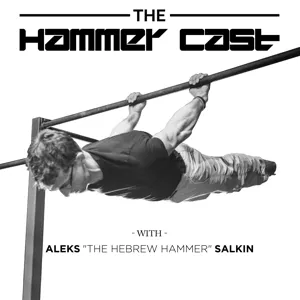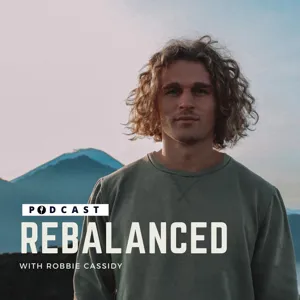Podcast Summary
The Power of Exercise and Physical Fitness for a Long and Healthy Life: Prioritizing regular exercise and maintaining a high level of physical fitness can have a greater impact on our longevity and overall well-being than any other factor.
Focusing on exercise and physical fitness can have a significant impact on both the length and quality of our lives. While there are other important factors to consider, such as sleep, nutrition, and emotional health, taking our exercise to a 10 out of 10 can be incredibly beneficial. Even if other areas of our lives are fairly balanced, improving our fitness level can have a greater impact than anything else. Of course, it's important to address any major health issues or deficiencies first, but for most people, prioritizing regular exercise and maintaining a high level of physical fitness should be a top priority for longevity and overall well-being.
Planning for a Remarkable Marginal Decade: Achieving a Fulfilling Life in the Later Years.: To ensure a fulfilling life in the later years, prioritize training for a set of activities known as the centenarian decathlon, focusing on mobility, strength, aerobic efficiency, stability, and balance.
Planning for a remarkable marginal decade is crucial for a fulfilling and high-quality life in the later years. A marginal decade refers to the last decade of one's life, where physical and cognitive health tend to decline. By aiming to have a remarkable marginal decade, it implies that all the preceding decades should also be remarkable. The analogy used is that of an archer, where practicing at a longer distance makes it easier to hit the target at a shorter distance. To achieve a remarkable marginal decade, individuals need to train specifically for a set of events or activities, referred to as the centenarian decathlon. This includes both activities of daily living and recreational activities. Prioritizing mobility, strength, aerobic efficiency, stability, and balance are essential for successful training.
Maintaining Physical Strength and Mobility for a Full and Active Life as We Age: The ability to perform daily tasks and handle emergencies effectively requires physical strength and mobility. Creating a personalized list of activities based on individual priorities and lifestyle preferences is essential for long-term health and vitality.
Maintaining physical strength, stability, and mobility is crucial for preserving independence and quality of life as we age. The list of activities mentioned by Peter Attia reflects the specific functional abilities needed to perform daily tasks and handle emergency situations effectively. It emphasizes the importance of being able to get up off the floor, lift and carry weights, climb stairs, maintain balance, and perform various functional movements. These activities not only help to prevent falls and injuries but also enable individuals to engage in recreational activities and play with their grandchildren. It is essential to create a personalized list based on individual priorities and lifestyle preferences, while also considering emotional well-being and cognitive health, which can continue to improve with age. By focusing on these specific goals, individuals can develop a training plan that supports their long-term health and vitality.
Prioritizing Physical Abilities as We Age: A Step-by-Step Approach: Understanding the stability and strength needed for specific activities and regularly assessing fitness levels are essential for maintaining physical abilities as we age.
It's important to prioritize and plan for physical abilities as we age. Simply making a list of activities we want to be able to do at a later age may not lead to productive outcomes. Instead, the approach should involve selecting 10 key items from a list of activities and considering what is required to accomplish them. Peter Attia emphasizes the significance of understanding the stability and strength needed to perform these tasks. While some may think they can easily do these tasks at a younger age, it's crucial to recognize that maintaining these abilities requires effort and work over time. Assessing metrics like VO2 max and strength can help gauge current fitness levels and set goals for the future.
Tracking Metrics and Knowing Your Body's Capabilities: Monitoring and improving physical fitness requires tracking metrics, understanding exertion levels, and assessing muscle mass to make informed decisions about fitness goals and progress.
Tracking metrics and knowing your body's capabilities is crucial in monitoring and improving your physical fitness. Different exercises, such as the dead hang or wall sit, can help measure specific areas of strength like grip strength or leg strength. Zone two, which is the threshold where you transition from being uncomfortable to not being able to speak, is important for tracking progress and determining lactate production during physical activity. Understanding your own level of exertion based on the Rate of Perceived Exertion (RPE) can help identify the appropriate intensity for zone two. Additionally, assessing muscle mass through a DEXA scan can provide valuable information about bone mineral density, visceral fat levels, and overall muscle mass. Overall, being aware of these metrics allows individuals to make informed decisions about their fitness goals and progress.
The Importance of Tracking Metrics and Tailoring Training for Overall Health and Longevity: Tracking metrics and tailoring training to individual objectives is crucial for long-term health, and prioritizing mobility and pain-free living can greatly improve overall well-being.
Tracking metrics like ALMI, HEMOGLOBIN A1C, VO2 max, muscle mass, and strength are important for overall health and longevity. While muscle mass is valuable, it's equally important to consider the effort and training required to achieve it. The conversation also emphasizes the significance of training specificity and balancing different physical activities, such as repetitive sports, to avoid movement issues and asymmetries. Training should be tailored to individual objectives and prioritize long-term health and function. The speaker, Peter Attia, shares his personal experience of a debilitating back injury, highlighting the importance of mobility and pain-free living. Specific and sometimes unconventional exercises focused on stability and movement can contribute significantly to overall well-being.
Optimal Training Schedule for Improving Fitness and Health: Starting with three hours per week is an effective minimum for overall health. Focus on steady state aerobic training, strength training, high-intensity aerobic training, and stability training. Overload training progressively. Identify and address deficits for a well-rounded fitness program.
Starting with three hours a week is an effective minimum dose for improving fitness and overall health. This includes one hour for steady state aerobic training in zone two, one hour for strength training, and around 30 minutes for high-intensity aerobic training. The remaining time can be dedicated to stability training, with 10 minutes a day spread out over six days being more beneficial than doing it all at once. It's important to progressively overload the training by increasing weight, reps, sets, or using other methods like BFR. The frequency of increasing training time depends on individual circumstances and the willingness to commit. Identifying and addressing deficits in specific areas, such as aerobic training, is crucial for a well-rounded fitness program.
Assessing Strengths and Weaknesses in Physical Fitness: A Personalized Approach: Recognize the importance of tailoring fitness routines based on individual strengths and weaknesses, seeking guidance, and addressing age-related considerations for optimal results and injury prevention.
It's important to assess your individual strengths and weaknesses when it comes to physical fitness. Just because running has been a successful exercise for one person, it doesn't mean it will work for everyone. For example, a lifelong runner with little muscle mass may need to incorporate strength training into their routine to address imbalances and common issues associated with running. Additionally, age is a factor that requires a nuanced approach to programming. However, age should never be seen as a barrier to improving fitness. Studies have shown that even elderly women with low bone density can significantly improve their strength and health through weightlifting. It's necessary to be consistent, have a sense of purpose, and seek guidance from knowledgeable professionals to avoid injury and make the most of your fitness journey. Women, in particular, should pay attention to bone mineral density as they age, as they are at a greater risk for lower bone density.
Importance of Maintaining Bone Density for Women and Effective Methods for Doing So: Women, especially those at midlife, should engage in load-bearing activities like strength training to slow down the decline in bone density and lower their risk of osteopenia and osteoporosis.
Maintaining bone density is crucial for both men and women, but especially for women who experience a significant decline in estrogen levels during midlife, putting them at higher risk for osteopenia and osteoporosis. While it is challenging to increase bone density after reaching the critical period of maturation in the 20s, it is essential to slow down the rate of decline through load-bearing activities. Heavy load-bearing activities, such as strength training, are the most effective in maintaining bone mineral density. Walking, running, swimming, and cycling are not as effective since they do not involve bearing load. When it comes to training without fancy equipment or a gym, bodyweight exercises can be helpful, but investing in some dumbbells, kettlebells, or resistance bands can make a big difference. It's important to be cautious and mindful of previous injuries and to start with lower weights, focusing on proper positioning and movement.
Taking an Active Role in Injury Rehabilitation: A Personalized and Holistic Approach: Stay informed and involved in your own care by seeking practitioners who tailor rehab programs to your specific injury. Dedicate time to rehabilitation and prioritize both cardiorespiratory fitness and muscle strength for optimal recovery.
When it comes to injury and rehabilitation, it is important to be an informed and involved consumer of your own care. It is recommended to align with practitioners who have a personalized and holistic approach to rehab, rather than following a generic program. When meeting a practitioner, take the time to discuss their philosophy around your specific injury and understand the trade-offs involved in the rehabilitation process. Do not give up on physical activity due to injury, as staying active is crucial for recovery. Ignoring a nagging injury can lead to further complications and atrophy. Invest time in rehabilitation, even if it means dedicating at least three hours a week to it. Focus on developing both cardiorespiratory fitness and muscle strength, and remember that the 80-20 rule applies to training volume, regardless of athletic ability.
Prioritizing Cardio Training within Personal Constraints: Dedicate about four to five hours per week to cardio training, with 80% of that time on zone two training and 20% on VO2 max. Spread out zone two sessions and incorporate a structured weekly plan with various modalities in suitable locations.
Peter Attia emphasizes the importance of dedicating time to cardio training while considering personal constraints. He acknowledges that due to various obligations, it may not be possible to commit excessive hours to training. Therefore, he focuses on allocating around four to five hours per week for cardio, with 80% of that time dedicated to zone two training and 20% to VO2 max. Attia suggests spreading out the zone two sessions, aiming for at least 30 to 45 minutes each time. He follows a structured weekly plan, incorporating strength training, stability exercises, and specific modalities like biking, swimming, running, and using a treadmill. Attia also highlights the relevance of finding suitable locations and terrains for different types of workouts, ensuring safety and effectiveness.
Maximizing training efficiency through zone two workouts and personalized intensity and duration.: Consistently maintaining a steady state churn in zone two and tailoring the workout intensity and duration over time leads to optimal results in VO2 max training.
When it comes to zone two workouts, it is important to maintain a constant steady state churn in order to harness mitochondrial efficiency. Simply accumulating 45 minutes in zone two based on heart rate is not enough because passing in and out of zone two disrupts the desired physiological effect. To effectively train VO2 max, the modality can vary, such as air biking, regular biking, stationary biking, stair climbing, treadmill running, or even outdoor running. The ideal duration for VO2 max intervals is three to eight minutes, avoiding exercises so intense that they cannot be sustained for at least three minutes. Personalization is key, and practicing over years will help determine the appropriate intensity and duration for optimal results.
Monitoring Progress in Improving VO2 Max: More Than Just Testing: Tracking your progress using a power meter and maintaining a healthy weight can indicate improvements in your VO2 max, but the focus should be on long-term training and overall quality of life.
Monitoring progress in improving VO2 max is important for staying motivated in your fitness journey. While testing your VO2 max more than once a year is unnecessary, there are other ways to gauge your progress. For example, using a power meter on a stationary bike or outdoor cycling can show you how much wattage you can handle. If you see an increase in wattage output over time, assuming your weight hasn't significantly increased, it indicates that your VO2 max has improved. Additionally, weight plays a crucial role in VO2 max, as it is measured in liters per minute divided by your weight in kilograms. Losing excess weight can lead to a significant jump in your VO2 max. Remember, the goal is to maintain a long-term training program and focus on the overall improvement in quality of life rather than just chasing short-term results.
Heartfelt Appreciation and Exclusive Benefits: Peter Attia's Gratitude towards his Book Readers and Subscribers: Peter Attia expresses deep gratitude to his book readers and values their feedback, while highlighting the exclusive benefits of his membership program. He is committed to providing valuable content to his audience.
Peter Attia feels a deep sense of gratitude towards the listeners who have purchased his book and supported his work. He expresses how personal and attached he feels to his book, more than any other content he has created. He values the feedback and messages he receives from readers, as it means a lot to him to know that his book has had a positive impact. While he may not be able to thank each person individually, he wants to express his heartfelt appreciation to everyone. In addition to discussing his book, Peter highlights the membership program he has created, which offers exclusive content and benefits to subscribers. He emphasizes his commitment to providing valuable content to his audience and ensuring they receive more than what they paid for.





